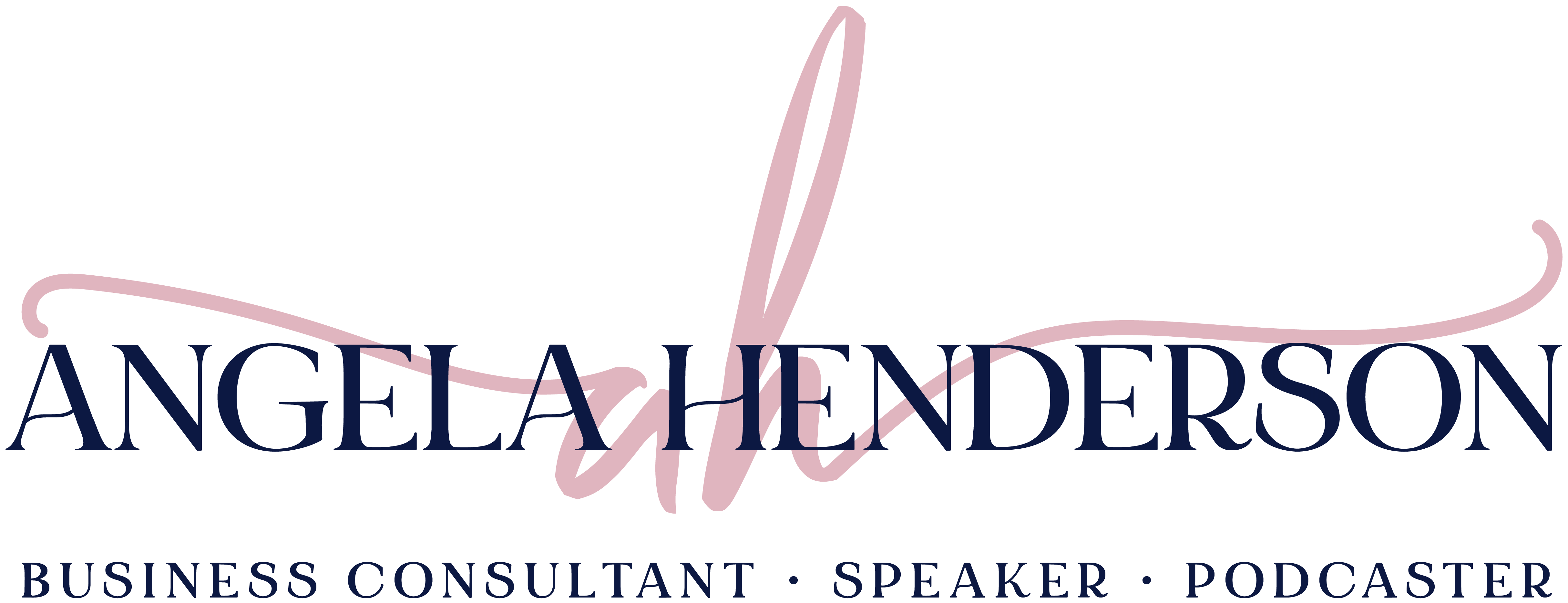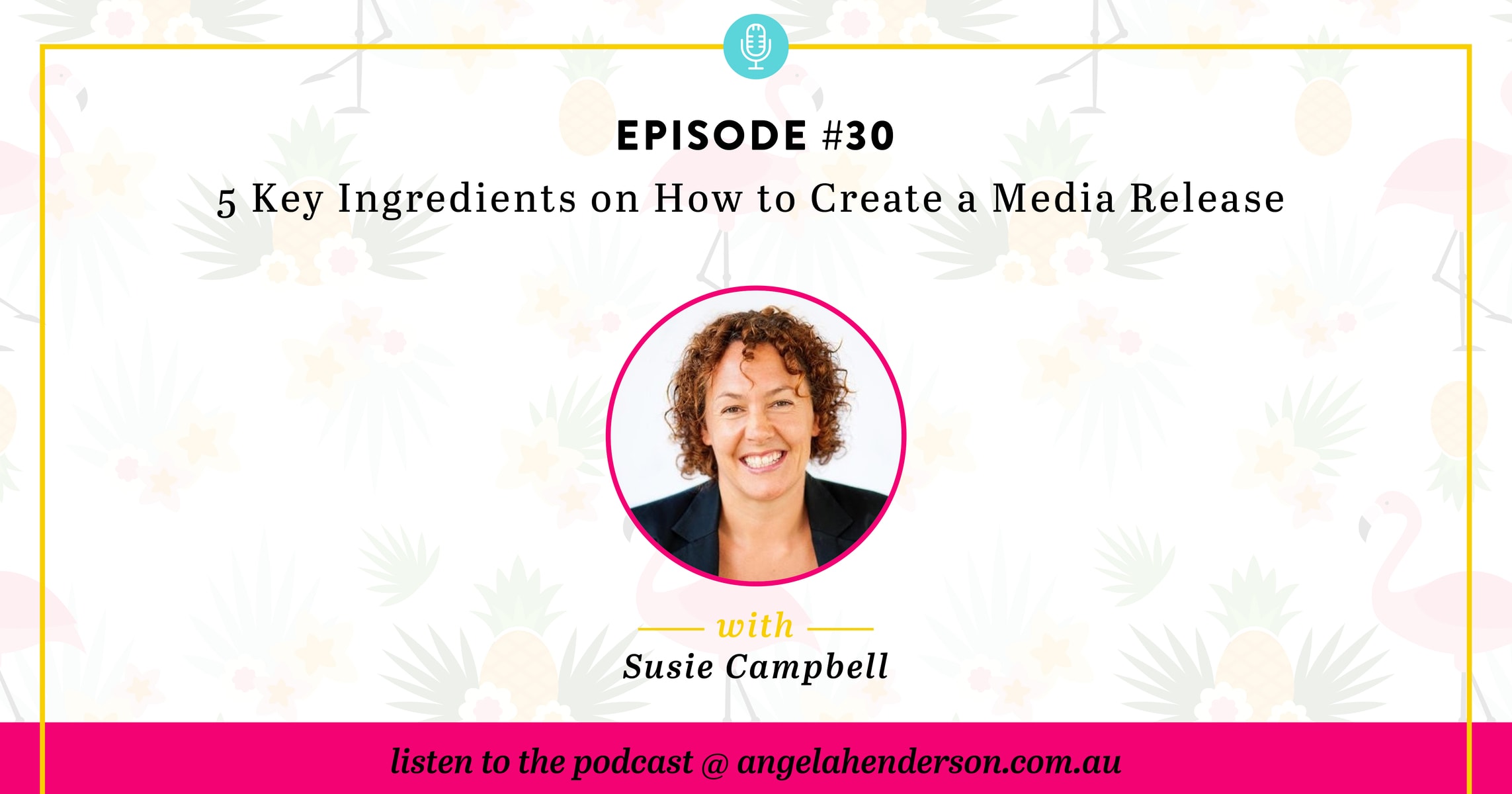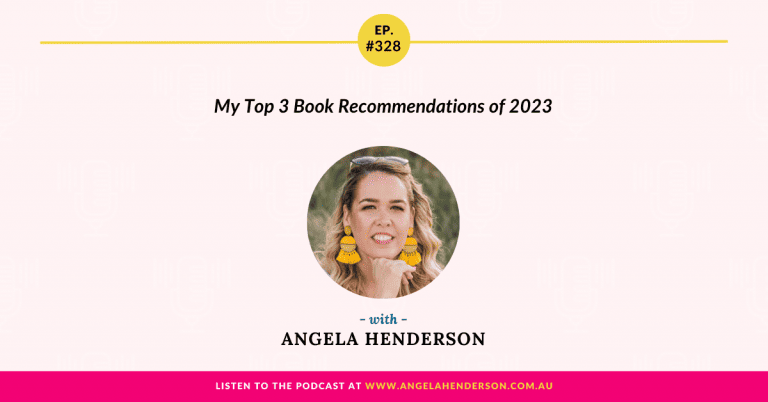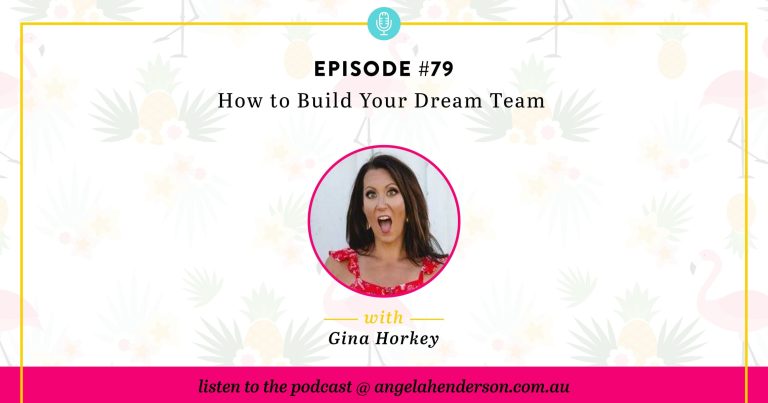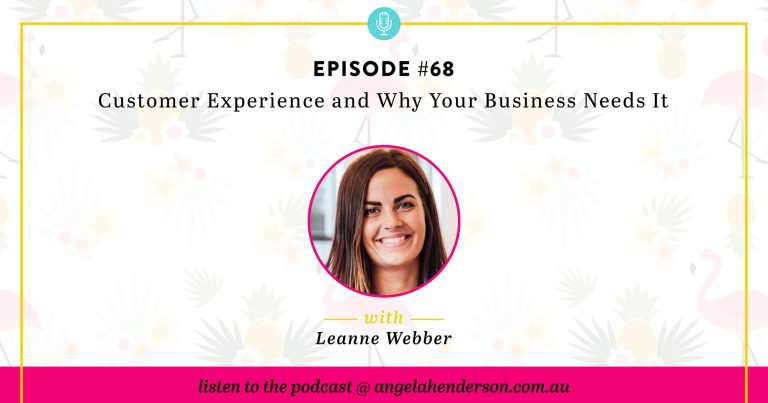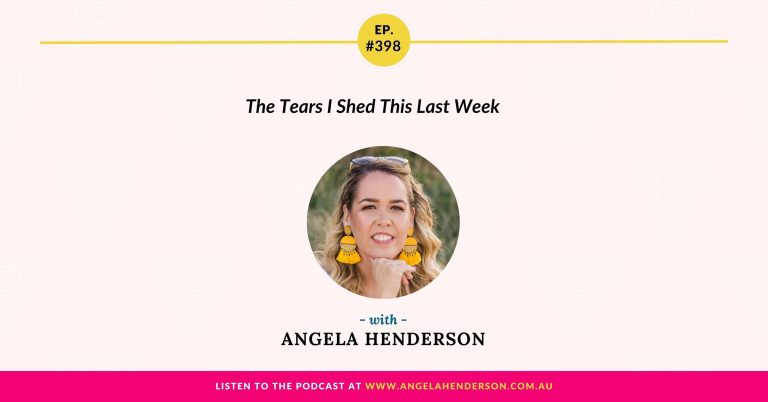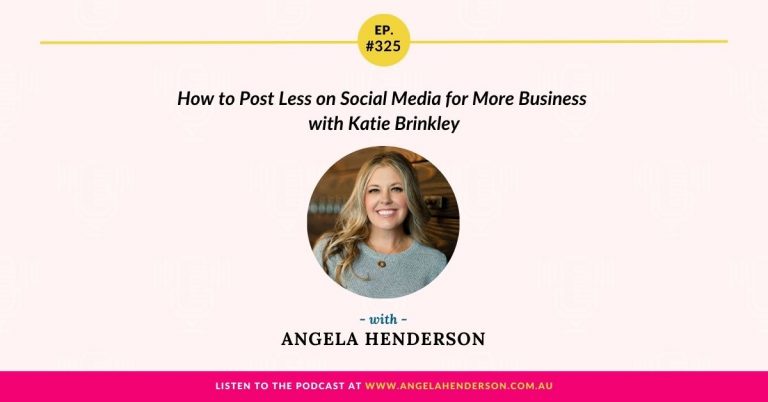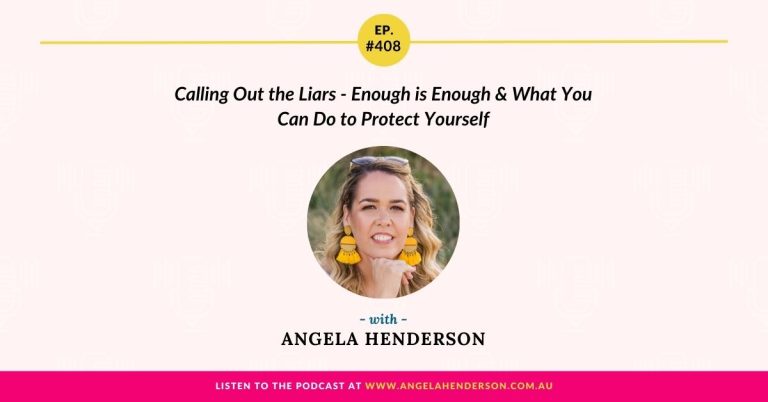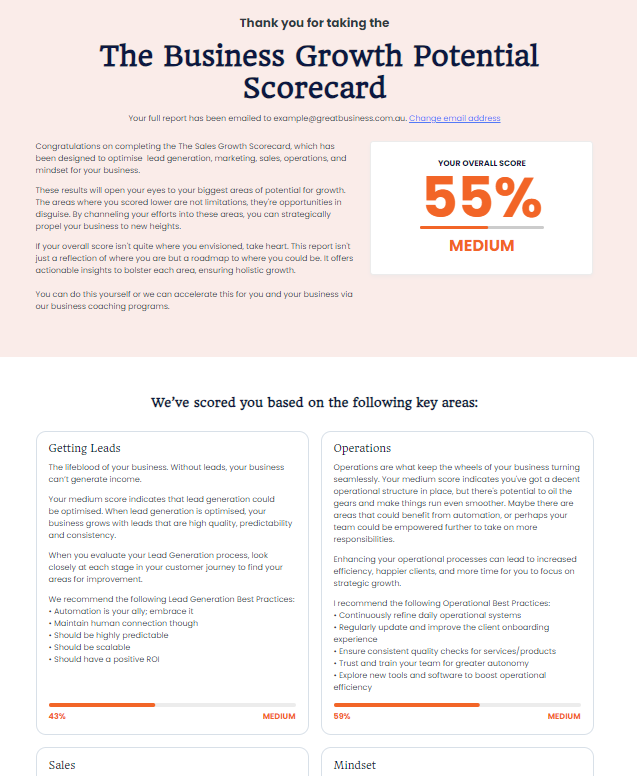In today’s tech-savvy world, online marketing has been the way to go for many businesses but have you ever thought about integrating media into your marketing strategy? Susie Campbell from Hullabaloo PR joins us in this episode to talk about the pros and cons of a media release and the importance of building a media profile for your business. She shares 5 key ingredients of creating a media release and 3 suggestions on how and where to publish it to help grow your business.
Important Links Mentioned in the Show:
Facebook Group: Ambitious Business Owners Become Known Become Famous
Angela Henderson Active Business Facebook Group
Angela Henderson Facebook Business Page
Prefer to read 5 Key Ingredients on How to Create a Media Release? Here’s the transcript:
ANGELA:
You’re listening to the Business and Life Conversations podcast, with Angela Henderson, episode 30.
Hey there, you’re listening to the Business and Life Conversations podcast, my name is Angela Henderson, and on this show we talk about improving your business, life or both. By having amazing and rich conversations with brilliant guests. Who will inspire you and who will give you tips and tricks, to help you grow both in life and in business.
Well, hey there and welcome back to another amazing episode of Business and Life Conversations Podcast and I’m your host Angela Henderson from Angela Henderson Consulting. Today we’re going to talk about the importance of a media release for business growth. And joining us on the podcast today is Susie Campbell from Little Black Book Marketing.
We’re going to be discussing what is a media release? Why would you choose to use a media release in your business, aka what are the benefits? Five key ingredients on how to create a media release, and Susie is also gonna give us three wonderful suggestions on where to send your media release once you’ve created, obviously, your media release. So without further ado, welcome to the show Susie.
Gosh. Well, thank you, I know we’re all very busy so I appreciate you popping some time aside to come on and talk about all things media and I’m super excited to have you on board today.
Now, before we jump in, again this is kind of stock standard for my podcast, I like the listeners to be able to get to know a little bit about you on a personal level and obviously and also on a business level before we hone in on obviously your expertise today, which is one element of your expertise I should say; media releases.
So, I want to talk to them about, you know, share a little with us about what brought you to Australia five years ago, and I also was really curious about how you became self-employed, because from what I remember reading somewhere is that you used to be a Royal Navy officer, and to now, a creative publicist and a marketer to startups. So, tell us a little bit about, to me, your story.
SUSIE:
Yes. It’s a funny one. So yes, I was in the British Royal Navy for about 12 years. I decided to come out for family. So my husband was also a serving naval officer, and we were literally ships passing in the night; one would be away and then the other. So we decided, “Well, something needs to give here.”
I got an urge to start my own business. I wanted to do something else, and so I decided to come out, and we knew we wanted children. So I left, and actually started a business in the U.K., helping other military people when they’re leaving the services to find a job in civi street.
That was quite a niche recruitment agency. I did that, and I also worked on a large retail project, retail management project in the U.K. with Tesco’s which some people will be familiar with.
ANGELA:
Yeah, the big supermarket chain, isn’t it?
SUSIE:
Very big supermarket chain, yes. Huge. So like your Coles, but even bigger. So yeah, and then my husband got offered the opportunity to transfer to the Australian Navy, and so we thought, “Why not?” And so, by which time I’d already got baby number one. And then we arrived in Australia and baby two was just three months old.
ANGELA:
Oh, wow.
SUSIE:
So I had two littlies. So yeah, so we came over here, primarily for his transfer, his job here. I’ve had this vision that I was gonna take a bit of maternity leave, chill out for a bit, relax, and I just couldn’t do that. So, I was itching to do something. I couldn’t sit around all day with two little ones. I didn’t know anybody here, we’ve got no family here, so I wanted to get out and start meeting people.
And so I started chatting to local people, connecting on Facebook. No idea what I wanted to do. I got chatting to a lady who had a couple of retail shops. She sold baby clothes, and nappies. And it was the cloth nappy thing, so I brought my boys up on cloth nappies, and she sold cloth nappies, and she wanted someone to help her with marketing.
And so I thought, “Well, I can’t actually go and work in the shop, and I sort of can’t do what she was asking.” So, I just sent her an email with a heap of ideas and suggestions for how she could market herself. She came back and she said, “I love all your ideas, please will you work with me?” So she was great and she allowed me to work flexibly, and so I just worked from home, contracted for ten hours a week, and I juggled it around my two kids. As soon as I could afford a day’s childcare, I put them in, and it just sort of grew from there.
I was her marketing and PR girl for about just over a year probably. But during that time, I connected with lots of other business owners because I used media, and partnerships, and did lots of creative marketing for her.
And so, word of mouth and referral, and before I know it, I had a handful of clients. I thought, “I ought to do this properly.”
ANGELA:
And that’s how Little Black Book Marketing came about.
SUSIE:
Absolutely, and it did become a little black book of contacts that I just started to build and build, and it’s what I did in the U.K. with the Navy. So, people are probably wondering, “How on earth do you go from the Navy to doing media and marketing?”
When I was in the Navy, I worked on some large projects alongside civilian contractors, and part of what I did was to organise.. one of them was a huge event, like a 30-40,000 people event. So, I needed to market that and use the media. And I did another project in the catering, retail, and leisure space and again had to do marketing and media.
So it was very practical, and I learnt as I went. So I’m not marketing trained. Everything I’ve done is from actually doing it. So I loved it when I was there, and so when I came over here, it didn’t even cross my mind to do it. But yeah, I just sort of naturally love creative marketing. So yeah, so I did it for her, and here I am.
ANGELA:
So, you moved over five years ago almost to the day from what I remember, in September I think sometime, and so how long has Little Black Book Marketing been up then?
SUSIE:
Well, nearly four years. Again, it kind of evolved. As I say, there was no set start date. So, when I was operating and helping this shop owner, I didn’t have a name, a website, nothing. I just registered ABN, it’s Susie Campbell. It wasn’t until, as I say, I got a handful of clients that I sat down.. I remember it vividly. I sat at my desk one day and I thought, “I ought to do this properly.” You know, “I’ve got four or five clients now. Don’t have a business name. Let’s do it.”
So it was.. The only way I can decide how long I’ve been running is to kind of look at my accounting software and when my invoices were. It was kind of around the end of 2014. So, I’d been here just over a year, when I made the decision, “This is it,” and came up with the name.
ANGELA:
Well goodness gracious, so fun, and sometimes that’s where the best ideas are formed. You’re not even thinking about them. I can relate to that, that with Angela Henderson Consulting, it was never even part of the business plan with Finlee and Me, my first business. It was that, people kept asking for cups of coffee, “Can I take you out?”. That was happening literally probably eight to ten times a month and I thought, “Hold on a minute.” And I’d have to buy my own coffee sometimes. And I’m like, “Well, if this is happening, and I charged a little bit per person, I could actually have a secondary business, and then have the consulting arm of it.” And yeah, so sometimes, you don’t even plan things, they just kind of happen and evolve, and that’s kind of.. I like it that way sometimes.
SUSIE:
Yeah, it was great, and I think, because there was no pressure, so it wasn’t, “Oh gosh, I’m in startup and I need to do something.” I’d already kind of started. I was already doing what I did. And so yeah, I didn’t feel that pressure, and I made a pact with myself that it would be profitable from day one. I didn’t have money to invest, and so every time my sales increased, I paid for another day’s childcare basically, until I could get them both.. and I got them up to sort of three or four days, and had a day-or-two off with them.
I did a sit-swap with another local lady that she used to take my youngest for a day, and I just grew it around that. And then now, well this year, my youngest started school, so now I am properly full time.
ANGELA:
In the trenches.
SUSIE:
Yeah, absolutely. But I grew my team as I went, so it wasn’t all me. So, I started growing my team from the first year. I took on a VA, and then I started taking people onto payroll, and now I’ve got four? Five? Four or five.
ANGELA:
How good is that? That’s fantastic, because what part of Australia are you in?
SUSIE:
Sydney.
ANGELA:
Sydney. Lovely. Great place, and obviously yes, it will keep you very, very busy there, and nationally, you know?
SUSIE:
Yeah.
ANGELA:
And so now, listen obviously, I love hearing about the business side, but on a side note, on a personal note, you have to tell us what’s your all-time favourite movie though because again, it’s good so people can see a little bit of the other side of Susie.
SUSIE:
Oh, okay. Well, I love The Shawshank Redemption, and I love the Tom Cruise movies, so Cocktail.
ANGELA:
Goodness, Cocktail. No, I haven’t heard that for a while.
SUSIE:
Yeah, so oldies. I mean obviously there’s some great new movies, but they’re sort of my all-time favourites.
ANGELA:
Yes. No, no, I do have to agree, I do love Cocktail. I do love a good Tom Cruise. Again, he is good eye candy, let’s be honest, to look at once in a while. So I mean again, that’s a totally another podcast probably, but anyway. Yeah, I do love it.
Now then, in the world where we’re at, businesses are growing very, very quickly. Technology’s growing very, very quickly. But there’s still some elements that have been around for a very, very long time, and anyone who’s worked with me knows I’m a huge believer in foundational growth. You have to have the foundations laid before you can really leverage and start to scale.
SUSIE:
Yeah.
ANGELA:
And one of those, I do believe, is that around doing media releases, press releases. And we’ll talk about that a little bit in a minute, but the importance of.. You know for example, businesses.. You know, we’re constantly turning to the social media outlets. You know, and people are really putting all their eggs in the one basket. You know a Facebook, LinkedIn, Instagram, Twitter, etc. To get the word out of the company, the new products, different news, etc. And even though each of these particular platforms do offer a unique way to create a positive brand, and reputation, and potentially even increase their sales, in my opinion and in my experience, what I’ve found is, these platforms will only spread the word so far. And again, that’s also depending on algorithm changes, how much you’re putting into advertising budget.
So for me it’s, I think, businesses really need to be looking at the bigger picture around the publicity side. And again, what we’re gonna talk about today is, one way that they could start doing this is through media. And so today I brought you onboard to be able to talk about; what is a media release? But I guess before we even jump into what is a media release, just for the listeners out there, so we’re not confusing anyone, Susie and I were chatting before the podcast about, some people might get confused between a press release, and a media release. So, do you wanna clarify that for the listeners out there Susie?
SUSIE:
Yeah, sure. It is exactly the same. Press release was a term used when traditionally, a press release was sent to the press, to the print media. Whereas these days, as you know, there’s more than just newspapers and magazines out there. People are using TV, and radio, and podcasts, and digital media, so there’s a lot more media types out there. So generally, it’s now known as a media release, as opposed to a press release, but fundamentally, it’s exactly the same.
ANGELA:
Exactly the same. Good. We’re just moving with the times, you could say.
SUSIE:
Yeah, totally.
ANGELA:
So, with so many marketing techniques out there, let’s be honest, there’s a guru for marketing every time I turn on Facebook. Someone says something, they give me quite conflicting information and again, I think the beauty is business owners will take a little bit of what we need to create our own kind of marketing techniques for our individual businesses.
SUSIE:
Yeah.
ANGELA:
But why, in your particular niche market, or with your expertise around media marketing etc., why would businesses want to choose a media release in their business, and really, what are the benefits of that?
SUSIE:
Yeah, so I always say to people, “If the public read about you in a paper, or hear about you on the radio, or see you on TV. Rightly, or wrongly, you have instantly elevated your positioning, your credibility, and positioned yourself as an expert, because let’s face it, if you’ve been interviewed on radio, you must be pretty good. They wanna talk to you. So, you’ve instantly bypassed, and if we’re looking at the marketing line of; no, like, try, trust, you’ve instantly gone to trust. They already trust what you say and who you are, because you’re on the TV, or you’re in the paper.”
And so, that’s one great reason to use media, it positions you straight away. One of the other great reasons is, not many small businesses do it. A lot of them don’t do it, because they don’t know how to, they don’t even think about it, they think they’re not media worthy, why would anyone want to read about my business? Or they think it’s really expensive, because there’s some PR agencies out there that will charge you thousands a month, and you get very little return, so they’ve probably heard the horror stories.
So that’s another great reason. Another great reason is because there aren’t many small businesses who do do it, or do it well, you can stand out from the very crowded digital space. As we know, to stand out with a Facebook ad, you’ve got to pump a lot of money into it, and even then, there’s no real guarantees it will work.
And yes, there’s no guarantees with media, but you’re instantly in a space that isn’t as crowded, because people aren’t using it. I always use an example of a client of mine recently, who is a relationship counsellor. He’d never used the media before, like everyone, have been using Facebook, social media, trying to get his name out there, had got an event and he’d actually cancelled the event, because he couldn’t fill it. He tried to promote it and got nowhere.
And so I said, “Let’s do a local media release. It’s a local event, let’s get your story in the paper.” And we did. We got him in on the Saturday paper, his local paper. The event was on a Tuesday, and by the Tuesday he filled it. And that’s from one media release.
And people say, “Well there’s lots of relationship counsellors near where he lives.” Yes, there is, but did they pitch their story to the paper? No, they didn’t. So, he’s instantly stood out. People have found him, they’ve read about him, he got calls afterwards as well, from people inquiring. And then he’s got a whole fresh new audience that he couldn’t reach through the digital space. So, it can be extremely powerful, extremely powerful, and very simple.
ANGELA:
And I think again there you’re breaking down some of those myths about the PR publicity side of things too, is that, it can be one of those you touch upon, about the expense. Now I will say, I’ve been working with a PR company now for a few months now, but before that, before I actually chose one, I didn’t know you at that stage Susie, before I chose it I will say that I literally had contact with.. off the top of my head it was either 13 or 14 different agencies across Australia, and I had kind of my scope, or project, what I was really looking for. Like I really wanna hit in Forbes, I wanna hit in Huffington Post, I wanna hit like all these, you know, I kind of had my wish list, and then there’s my reality list, right?
SUSIE:
Yeah.
ANGELA:
The prices literally range from, for what I wanted. Now remember, for those that are out there, I’m not saying everything that you want is gonna be say, $900 a month for example, right? But, roughly nine hundred to a thousand dollars a month for what I wanted. There are other things that you might only want half of what I want, so it could be less expensive. Okay, so let’s just clarify that. And then, for the same stuff, other agencies was literally quoting me $15,000 for the month, for the exact same thing.
SUSIE:
Yeah, doesn’t surprise me.
ANGELA:
Now, I almost fell off my chair, because as a small business owner, like you’ve just spoken about, who wants to do something a little bit different and test, because I’m all about testing and not putting all my eggs in one basket. So, if PR does work for me for example, through media releases etc., then obviously yes, I wanna try that, I wanna work with it. But if it doesn’t, well then, I try something different. But I’ve never tried it before, because again, I thought it was too expensive. So, in the grand scheme of things yes, you know, say a $1,000 a month to $15,000. And again, there’s no guarantees, right? I was quietly freaking out going, “Oh my goodness, what do I do with this? Like $15,000 that’s, an enormous amount.” And the risks.
So yeah, interesting that you bring that up too, because not all agencies are expensive. So, for those that are out there, afterwards we’ll give you Susie’s details to contact, but definitely don’t be put off if you call the first two people and they’re quoting you larger numbers. Not everyone, is like that. So, I think that’s important, to talk about
SUSIE:
Yeah, it is important, and there is a difference between agencies, as there is with any business service.
ANGELA:
100%.
SUSIE:
One web developer is not the same as another. So yes, and I think, and that’s what I always say to people as well, it’s.. I try to educate my clients as I go, because I think it’s really important that they understand what I’d be doing for them and how I’d be helping them, because there’s nothing worse than them having this sort of expectation, or idea of what’s gonna happen, and actually, it’s just not realistic.
So you know, had you come to me and said, “I wanna be on Huff Post, and Forbes,” and blah, blah, blah. I would’ve said, “Right, let’s rewind. Have you got a media profile yet?” “No.” “Let’s build that up.” And lots of people will overlook their local media, because they turn their nose up at it and think, “Oh, it’s just the local paper. It’s nothing.” But actually, it’s the first stepping stone in getting into the media, and you build credibility not only for your business, but amongst journalists and other press, because don’t underestimate how much they’re looking at you.
So once you get coverage, journalists are scouring papers for stories and picking up. And if you keep appearing and, “Oh, she’s been in a local paper, and she was on the local radio, and she’s been on ABC Podcast,” or whatever it might be, you start to build up a media profile, and that becomes attractive because you’re less of a risk to them in the future. Because you’re already kind of talent checked by other media that’s covered you.
ANGELA:
You’ve been screened.
SUSIE:
Yes.
ANGELA:
Yes.
SUSIE:
So, more likely to use you.
ANGELA:
And I would agree. Again, in my experience in the last few months, because I have had a bit of media profile with my first business. We were able to leverage that. Like I worked with Netflix as one of their Top 30 Bloggers, and I worked with P&O Cruises and a bunch of those other. So they knew, “Hold on, these bigger brands aren’t gonna work with her unless she’s got some credibility.”
SUSIE:
Yeah.
ANGELA:
But whereas we work with clients of mine who have none, and again, you’re very right, you can’t look at the big picture like Forbes or Huffington Post until you’ve got some credibility, and it has to start somewhere. You have to start somewhere.
SUSIE:
Yeah, totally.
ANGELA:
And just because you have credibility on Facebook and Instagram, doesn’t mean that journalists see that credibility as the same-same, because they’re in a different..
SUSIE:
No.
ANGELA:
.. they’re in a different field. So I think that’s also another important thing to … It doesn’t matter if you got two million followers on Facebook, but if you’ve got nothing else, they will also wonder. And that’s why it goes back to, “Don’t put all your eggs in one basket.” You gotta make sure that you’re playing the field, you know?
SUSIE:
Totally. And journalists aren’t daft, they know that people can buy followers and likes. There’s lots of fake profiles out there.
ANGELA:
Don’t get me started, yes.
SUSIE:
It doesn’t mean anything to them.
ANGELA:
It does my head in. I’m like, “Really? You.. Really? All of you guys are all on an Instagram Pod, and you’re all commenting on everything.” I’m like, “But, whatever.” But some people just look at numbers. You know, that’s a whole other podcast, but yes.
SUSIE:
Yes.
ANGELA:
You know, for those listeners out there, they’re like, “Okay, great. Susie and Ange, I really.. You’ve sold me on having to, look outside of those regular social media platforms. And some of the traditional media platforms I guess you could say, like local paper, radio, etc.” What would you say for those who are starting, whether or not they’ve got money to spend, or maybe they don’t have money to spend? What would you say are the five key ingredients of how to create a media release?
SUSIE:
Okay, well ultimately, first of all you gotta find your story, because a media release is a story. It’s not an advert, it’s not something that’s promoting something, it’s a story. I always say to them, “Well pick up your local paper, read the editorial stories. Ignore all the ads and the paid ads that have got URLs and links to special offers, because they’re all paid for. Look at the pure editorial stories. Are they overtly selling you something? No, they’re not. They’re telling a story that you want to read.”
So first of all, it’s about finding your story. And when you’ve got that, you’ve got the bones for your media release. Then there’s a few logistics of a media release. So, a media release should fit to one page. It’s another myth, and you’ll see a lot of big brands, and I get PR agencies sometimes sending me media releases, and I’ve had brand ones sent to me, and they’re reams long, or they’re covered in logos and links. No, none of that. Journalists are not interested in any of that. It’s gotta be one page. It’s gotta be succinct, and don’t include any pictures or attachments, or external links. Not required.
The other really important thing, and I find a lot of small businesses trip over on this, is that it’s one release, one story angle. Don’t try and tell the whole story of your business in one media release. It’s not gonna work. The journalist needs to be able to find one strong, meaty hook in your story, and that’s the hook, and that’s the story.
If they then read on and, “Oh, she’s done this,” and, “Oh, she’s telling me about that.” You’ve lost them, because all of a sudden, they can’t see what the story is, because there’s too many.
Some people find that really hard to do, and they download everything on there and they want to tell me everything. “Sounds great, we’re just going to pick one little bit.” And they will tell me, “Ha, look but you’ve missed this really important bit and there’s this great bit.” “That’s okay, that’s another story.” But they will find out about that by using this one story. It’s all inferred in there, and they will find it.
So, another example I use is of a lady who, I pitched to an agency radio show, and she wanted to promote what she does in her business, but she had a book. I knew she had a book, but I wasn’t pitching a book. I was pitching her story and what she did. So anyways she got picked up and it was a great show, and the book then happened to get mentioned, just in the general conversation that the interviewer spoke to her about.
The very next day, she got a call from a Sydney bookstore who wanted to stock her book. Now, we didn’t pitch her book, and this is what I try to say to people. Yes, she got that. Yes, she had this business, and she’d done this, and I think she got her own podcast. You know, yes, we know that. One story, one release. Far more powerful.
The next thing is, and it’s just a little tip, media releases are written in the third person, not the first person. Again, it’s something people forget. They try to tell a story as if it’s from them, but it’s not, it’s all written in the third person.
I suppose a final thing is, it’s the headline. Having a really killer headline is a great way to hook a journalist, and that headline is not just on the actual document that you attach in the email, and paste in the email, it’s the title of your subject line as well, because that’s what’s going to attract the journalist’s or the producer’s attention.
Don’t just put, “Media Release Attached,” or your name, or your business name, that means nothing to them. You’ve got to remember, that journalists are getting upward of a hundred pictures a day, depending on who they work for. They will just delete anything that is not attractive and makes them want to click open. So, like click bait on a Facebook post, your headline has gotta be click bait. It’s gotta make them want to open your email and read your release.
ANGELA:
Perfect. So really, to recap how to create a media release, we one, wanna find a really cool story that is no pitch zone really, but again, something that tells a story, brings people along that journey. Two, we wanna make sure that the media release is one page with no frills. We don’t want pictures, we don’t want links, we don’t want logos, we just want, what is the story? And then tip number three as you said Susie is, we want one release, and one story angle. We don’t wanna over saturate them, we don’t wanna lose the journalist. We wanna keep it succinct, to the point.
SUSIE:
Yeah.
ANGELA:
Four, we wanna have your media release written in third person. And five, as you just said Susie, we want a really killer headline. You know, again, as you said, it really wants to be click bait, because we want the journalist to.. for that to stand out in their email inbox and go, “Yeah, I wanna at least explore what this person has to offer.”
SUSIE:
Totally.
ANGELA:
So what, wonderful, simple, and again, I would say that people probably over complicate things sometimes Susie. So if they go back to the five tips that you’ve just mentioned on how to create a media release, then more than likely, again, they’ve got their foot in the door, more than the majority of people who are trying to create a media release.
SUSIE:
Yeah, and the story is crucial. You know, if it’s not perfectly written and there might even be a typo in it. You know, it’s not gonna be perfect, it’s the story they’re after. And again, I use an example of when I first came to Australia and I was trying to get to know people, and I decided to run a charity event, to get to know some of my neighbours and invite them along for a charity that was close to my heart, and linked to a story I had.
Now I knew this was a great story, and I knew the local paper would want to cover this. As it happened, it got picked up by the state paper as well. But I didn’t even.. I didn’t write it in a formal media release. I found out the local paper’s contact details. I wrote the story. I emailed it to them. By eight o’clock the next morning they’re on the phone to me. I didn’t follow protocol, I just wanted to get the story to them. I knew they would bite a hand off for it. So, the content is crucial. If you’ve got a good story, generally, the media will take it.
ANGELA:
Yeah, perfect. So again, because again, when they publish it on whatever platform they’re publishing it, they want it to stand out. In a world where things are very noisy, whether or not that’s in newspapers, online, radio, they want to have a unique point of difference. So those things that people are pitching, really need to stand out.
SUSIE:
Yeah, well they’ve got to sell papers, or get readership, so they need their readers, listeners, to read and listen. So, they’ve gotta be picky and there’s only so much space in a print publication. Local paper cutbacks have meant that a lot of them aren’t publishing daily anymore. You have to fight for space, so it’s harder to get in it. So they can be selective. And they turn away more than they take. Same with radio, you’ve got to have a good story. The airtime is valuable.
ANGELA:
So once the listeners out there have put your five tips on how to create a media release to good use, can you give the listeners a couple suggestions on where to send their media release once they’ve created it?
SUSIE:
Yeah, certainly can, and this is another really important point. Who your media release is written to, so the media target, is crucial. You will write a media release with a media target in mind. And this is one of my big bug bears about some of the big PR agencies, they will write one release, and they will fire it out to as many targets as they can, and it’s not being tailored to that media target.
So, the way you would write to a print, is different to radio, is different to TV, is different to which state it’s in. There are so many variables. And so, if you’ve got, say three or four targets that you feel it’s appropriate to, that’s fine, but make sure you tweak the text in your media release.
A very simple example is, if you are sending it to a state paper, and a local paper, you would change the word to, “Local Sydney girl,” woman, whatever, as opposed to.. Sorry, “Local,” and the suburb name, as opposed to, “Sydney local.”
So, it’s just simple things that need changing. So the target is crucial, and you write the media release with the target in mind. And therefore, where you pitch it is based around, well where are your customers? So, it’s no good doing a release in your state paper, if actually your customers are only in your immediate locality. So, if you were a local hairdresser for example, you’re not interested in trying to reach people 50 kilometres away.
So, you’ve got to understand where your customers are. You’ve also got to understand what is your aim with this media release? Are you trying to sell products? Are you trying to raise awareness of your personal profile?
So, if you were say.. Let’s say you sold fashion items. A great media target could be a fashion magazine, one of the glossies, or something. But if you were a business owner, and you actually sold fashion, but your aim was to raise your profile as a business woman and an entrepreneur, you might do a release into a business publication on that occasion.
You’ve got to think about the purpose of what you’re trying to do, and who you’re trying to talk to, and you’ve got to make sure that what that story is, is relevant to that readership. So, I write for Inside Small Business quite regularly, so no good be me talking about good brand names in a small business publication. I might reference them to give examples, but I’ve got to make sure it’s tailored to the small business community.
And so, it’s really important, when you’re picking who to send it to, that you know why you’re using them, understand their readership listener base, whatever it is, and write to them.
ANGELA:
Gosh, what a good summary that you’ve just given us in regards to.. and those tips, because there’ll be people out there, probably going, “Ooh, I didn’t think about that.” Or, “Oh gosh, I probably should’ve done that.” Or, “Yeah, I just blasted every.. email to the same people and didn’t tweak it.”
It’s the same thing when I work with media companies for some of my clients. And I’m like, “Corporate language is gonna be different to local language.”
SUSIE:
Totally.
ANGELA:
But it’s very different. So, if you’re pitching .. Even their media kit. I’ll say, “Your media kit, you need to have two or three of them, depending on who you’re pitching it to, because they’re gonna wanna see that you’re a little bit more upscale market.” You know, whereas like if it’s a local, they might not want all the gloss, because maybe they don’t fit or see themselves in that.
So again, people need to be very mindful about who they’re sending this information to, regardless if it’s a media release, or if it’s a media kit. You know, you always have to consider who’s receiving it on the other end.
SUSIE:
Totally, and yeah, good point, the language you use is vital. I have so many people who speak in their industry language. Coaches start talking about NLP, and mindset, and yah-da-yah. No, the general public going through a local paper, the general public don’t know what that is, and I guarantee the journalist doesn’t know what that is. Journalists know a little about a lot of things, and you’ve got to remember that, whereas you know a lot about your little thing. So, you’ve got to talk in widely used language.
ANGELA:
Then again, I think again, don’t over complicate it. Keep things simple.
SUSIE:
Yeah, totally.
ANGELA:
And sometimes, again, people this .. it needs to be relatable. So, well Susie listen, it has been a blast today having you on the podcast to talk about how to create a media release. But for those listeners out there who would like to get in touch, potentially stalk you, there’s always a little.. You know, there’s nothing wrong with a healthy stalk to see where you are, Susie. Where can they find you?
SUSIE:
So, you can find me in my Facebook Group, which is called Ambitious Business Owners Become Known, Become Famous. You can find me via my website: www.hullabaloopr.com.au that’s got all the links to me. And I love, just call me, email me, I’m very happy to connect with people and we’ll chat about media all day.
ANGELA:
Dude, I think again I could probably chat all day, also.
I appreciate you taking time out, again you’ve got a busy schedule, so I appreciate your wealth of knowledge on this particular topic about how to create a media release and for all those others, my team and I will also be putting together the whole transcription for this episode at www.angelahenderson.com.au and of course, I cover all sorts of related business and life topics inside my Facebook group, The Australian Business Collaborative. We’re getting close to almost 4,000 business members, so make sure you join us because I love connecting with people. I love connecting even more face to face, but The Australian Business Collaborative Facebook group is a good starting stone.
So for all those, have an awesome day, no matter where you are in the world and I look forward to connecting with you soon. And thanks again, Susie!
SUSIE:
Thanks very much, Angela.
ANGELA:
Bye!
Thanks for listening to the Business and Life Conversations podcast with Angela Henderson, How to Create a Media Release. www.angelahenderson.com.au.
